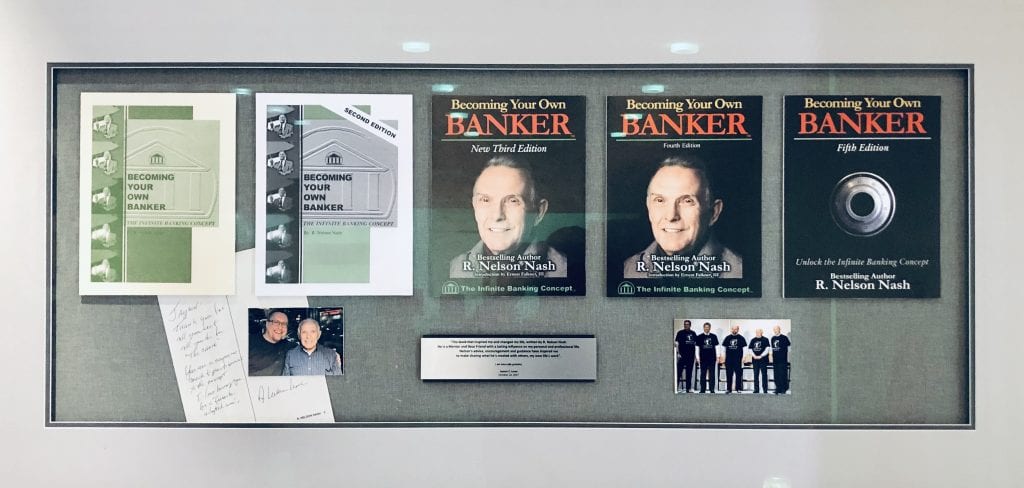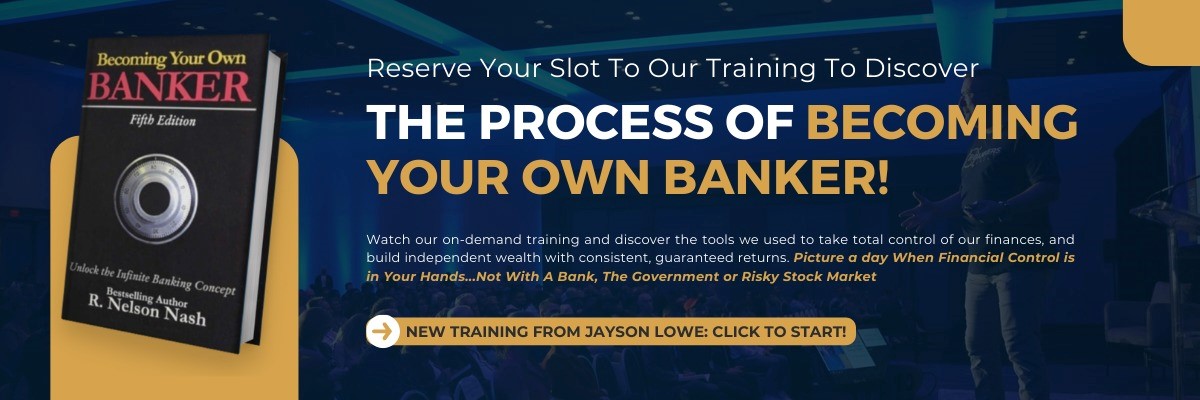The Infinite Banking concept, also known as IBC, was pioneered by Nelson Nash. Nelson Nash states, “The whole idea is to recapture the interest that one is paying to banks and finance companies for the major items that we need during a lifetime, such as automobiles, major appliances, education, homes, investment opportunities, business equipment, etc..” To simplify it even more, the Infinite Banking Concept is a way to save money. Instead of paying banks for things we need, like cars, houses, and school, we can invest in ways to keep more of our money for ourselves. It’s an ideal personal banking alternative for those who want greater control over their finances.
The Infinite Banking strategy takes a revolutionary approach toward personal finance. It essentially involves becoming your own bank by utilizing a dividend-paying whole life insurance policy as your bank. This counterintuitive scheme moves away from traditional banking institutions and hands the reins of finance to the individual. It substantially grows over time, transforming the standard life insurance policy into a sturdy financial tool.
While life insurance companies and banks risk with the fluctuation of the market, the Infinite Banking Concept negates these risks. Leveraging a cash value life insurance policy, individuals enjoy the benefits of guaranteed growth and a death benefit protected from market volatility. The life policy enhances savings over time, amassing more money than traditional banks. Insurance companies back this strategy, providing consumers with advanced control over their financial life, reinforcing the many potential benefits of the Infinite Banking Concept.

What is the Infinite Banking Concept?
The Infinite Banking Concept is a process that allows individuals to become their own banks. This process involves using whole life insurance policies as a financial tool. Whole life insurance policies accumulate cash value over time. Over decades, this cash value grows, providing a personal lending pool. Personal lending pools offer liquidity and financial flexibility. This flexibility helps us finance vehicles, property, investment opportunities, business equipment, etc. At Ascendant Financial, we teach the ‘’Infinite Banking Concept’,’ which was conceived by the late R. Nelson Nash. According to Nelson Nash’s book titled ‘’Becoming Your Own Banker’’ and “Building Your Warehouse of Wealth”, Nelson discusses the impact of financing with third party banks and lenders over a lifetime. The Infinite Banking Concept illustrates how much wealth is permanently transferred away from your Family or Business.
Nelson also goes on to explain that “you finance everything you buy…you either pay interest to someone else or give up the interest you could have otherwise earned”. The real power of The Infinite Banking Concept is that it solves this problem and empowers the Canadians who embrace this concept to take control back over their financing needs and have that money flowing back to them versus away. It is often misunderstood, but this includes the cash purchases that one makes over a lifetime as you are still working with borrowed money, even when you pay cash for things. This is called lost opportunity cost. When you pay cash for things, you permanently give up the opportunity to earn interest on your savings over multiple generations. To solve this problem, Nelson created his own banking system through dividend paying participating whole life insurance policies, ideally through a mutual life company. It has been called many things over the years, including Infinity Banking, Cashflow Banking, The Perpetual Wealth Code, The Money Multiplier, and many other variations.
How Does Infinite Banking Work?
This strategy works by purchasing a dividend-paying whole life policy from a mutual insurance company. The individual is then able to borrow against the policy’s accumulated cash value growth, using policy loans that would not require credit checks, and their credit score remains unaffected. It is worthwhile to note that such an approach offers a unique blend of life insurance coverage that is broader than a term life insurance policy with a cash flow strategy that benefits from significant tax advantages. This system serves as an alternative to traditional banking and offers a unique way to generate passive income through infinite banking.
When managing these accounts, many prefer to work with a financial advisor to ensure they are maximizing their potential benefits. Here, sheathed from market volatility, the account can function much like a high-yield savings account, available for funding unexpected expenses or even planned significant outlays. Any borrowing is then repaid back into the account, increasing the policy’s balance and allowing for further cash value growth. In the realm of infinite banking, the dual advantages of managing personal expenses while enjoying continuous growth offer a truly innovative way to look at personal finance.
What are the Advantages of Infinite Banking?
Advantages include:
- Protects against financial uncertainties by positioning life insurance as a significant asset
- Allows borrowing from policy loans for financial needs like medical bills or credit card debts
- Offers a non-correlated asset unaffected by market turbulence
- Promotes financial independence strategies with a stable investment path
- Enables access to a personal lending pool for financing vehicles, property, or business equipment
- Maintains consistent monthly payments and life insurance premiums regardless of cash value usage
- Shields assets from creditors in many jurisdictions
- Creates an economic safe haven through protected cash value and death benefits
- Promotes tax-free growth of cash value
- Diverges from traditional life insurance industry norms
- Alleviates concerns about outliving one’s money
The infinite banking concept positions your life insurance policy as a significant asset to protect you against financial uncertainties. You can borrow from life insurance policy loans in the case of financial need, like medical bills or credit card debts. Unlike borrowing from a bank or a credit card, this policy loan is a non-correlated asset unaffected by market turbulence, offering a more stable path for your investment strategies. A salient advantage of infinite banking life insurance is its liquid asset capability. In other words, your cash value can be used at any time, for any purpose, without affecting the frequency of your monthly payments or your life insurance premiums. This type of life insurance also harbors a unique resilience to creditors seeking payment. In many jurisdictions, the cash value and death benefits of life insurance are protected from creditors, providing an economic safe haven. Additionally, the infinite banking model promotes tax-free growth of cash value, distancing it from traditional life insurance industry norms. It’s a strategy that encourages storing many months of living expenses without the concern of outliving your money.
Are There Disadvantages of Infinite Banking?
While recognizing the many benefits of infinite banking, one must also weigh the potential drawbacks. The Infinite Banking system requires a significant commitment and a certain degree of risk tolerance. Unlike traditional investments such as real estate, where you can see growth or returns almost immediately, the accumulation of cash value in an infinite banking policy over time is a slow process, similar to how continuous compounding works. Instead of offering immediate or short term gains, it builds a financial foundation for the long term and thus requires a substantial period of time to see substantial results.
Alongside this, access to funds can also pose a challenge. Although the Infinite banking concept, a registered trademark, does provide protection from creditors, it does not guarantee unrestricted access to funds sheltered in the policy. This could limit cash flow and immediate investment opportunities in your estate. Your tax bracket also plays a role in how beneficial the policy is; individuals in higher tax brackets will see more benefits. Lastly, the cash surrender value of your policy can affect the opportunity to gain full advantage of your policy benefits in the early years. As a result, policyholders must carefully evaluate their financial goals and timelines before opting for this strategy.
Infinite Banking Course – Register for FREE!
Sign up for our Infinite Banking Course. Recapture the interest that you pay to banks and finance companies for the major items that you need during a lifetime. Build and keep your Personal / Business wealth without Bay Street or Wall Street. Make sure to register and access the training we have put together to discover how you can Implement The Infinite Banking Concept into your life. Remember, The infinite Banking Concept is a process and it can radically improve everything that you are already doing in your current financial life.
How Long Does Infinite Banking Take?
The duration for establishing and making substantial gains through infinite banking largely depends on various factors distinctive to an individual’s financial position and the policies of the financial institution catering to the service. Generally, infinite banking policies diverge from traditional banking practices and are structured around universal life insurance or dividend-paying whole life insurance rather than conventional personal banking procedures. These policies require an individual to pay policy premiums, which, over time, contribute to a cash value that can be borrowed against, similar to taking a personal loan. As such, the length of time required for infinite banking to be effective hinges on the policy type, frequency, and amount of additional premiums paid, along with the policyholder’s financial protection needs and overall fiscal conduct.
Unlike traditional banking mechanisms where instant sufficient cash availability is frequently a concern, infinite banking works best when allowed to grow overtime. As this concept relies heavily on the build-up of cash value within banking life insurance policies, it can take a few years, often a decade or more, before a policy generates enough cash value to support significant cash value loans. However, once established, these policies offer lifelong coverage and a permanent solution to financial life. It is important to maintain a robust financial position and be patient, as this is a long-term strategy designed to eventually eliminate the need for banking institutions and enhance overall financial control.
Is Infinite Banking a Good Idea?
Yes, Infinite Banking is a great idea and a potent financial strategy. Often touted by life insurance agents, this method enables individuals to essentially become their bank, with their life insurance products serving as the financial backbone of this system. It is predicated on the life company’s ability to provide annual payments based on the policy value, which can amount to quite a significant sum with the right strategy. For instance, should the policy accrue an appreciable amount, a life insurance payouts could function as loans where a payment schedule would be followed, potentially leading to financial independence. Furthermore, an annual dividend payment is another huge benefit of Infinite Banking, further emphasizing its attractiveness to those geared toward long-term financial growth.
However, this approach requires careful consideration of life insurance costs and the interpretation of life insurance quotes. It’s crucial to examine your credit report and confront any existing credit card debt to ensure that you are in a favorable position to adopt the strategy. Engaging with credit bureaus or your credit union can provide substantial insights into your financial status and the feasibility of infinite banking for your individual circumstances. Furthermore, it’s essential to consider your specific needs and the potential impact on life insurance beneficiaries. For instance, incurring a loan against your policy may decrease the potential payout to beneficiaries. Therefore, while infinite banking can provide impressive benefits, it also necessitates careful analysis and thoughtful planning.
How Much Money Do I Need to Start Infinite Banking?
Initially, the amount of money needed to start depends largely on the individual’s financial goals, the size of the desired death benefit protection, and the capacity for additional money to be put aside regularly. It’s important to remember that infinite banking is a long-term strategy meant for wealth accumulation rather than quick gains. The money employed is similar to a bank loan but instead of being deposited in cash in commercial banks or left in dormant savings accounts, the funds are channeled into a life insurance policy. Though not typically used for major expenses, the funds can be retrieved when liquidity is needed, which establishes a distinct advantage over traditional banks.
In the Infinite Banking Concept propagated by Nelson Nash, individuals become their own banks, lending and paying back with interest, thus creating ongoing cash flows and controlling the level of risk. A key aspect of this strategy is that there is insensitivity to market fluctuations due to the nature of the non-direct recognition loans used. Unlike investments linked to the volatility of the markets, the returns in infinite banking are stable and predictable. However, extra money over and above the premium payments can also be added to speed up growth. When it comes to estate planning, this strategy can be quite beneficial since it allows for the transfer of wealth without the burden of estate taxes. Therefore, while the initial investment may seem substantial, the long-term benefits and financial independence provided by the Infinite Banking Concept make it a worthy consideration.
What is the Cash Value Accumulation Rate in the Infinite Banking Concept?
The Infinite Banking Concept underscores the importance of cash value accumulation, allowing policyholders to draw upon the accumulated value for a variety of purposes throughout the duration of their insurance. This cash value accrual within a policy’s structure develops as the policyholder pays their annual premium, with both the funds and potential dividends stemming from the insurer’s profitable ventures. Essentially, the cash value serves as a sort of collateral that permits the policyholder to borrow from their own premiums, thus enabling them to avoid the stringent loan terms typically associated with banks and other common types of lenders.
However, careful planning and financial acumen must be exercised when managing the outstanding loan since the death benefit can be reduced if the loan is not repaid. Similarly, if the mutual funds in which the insurer invests do not perform as anticipated, this could also affect projected dividends and, thus, discretionary funds. Additionally, policies often offer term rider options, essentially an extra cost for extending coverage beyond the policy’s initial term. By prioritizing permanent coverage and the steady growth of cash value, the policyholder has the potential to optimize the effectiveness of their financial planning and carve out a pathway toward financial independence.

How Do Premium Payments Work?
Premium payments are a fundamental aspect of the Infinite Banking Concept strategy. Policyholders make regular premium payments into their participating whole life insurance policy to keep it in force and to build the policy’s total cash value. These premium payments are typically structured to be consistent and predictable, ensuring that the policy remains active and the cash value continues to grow over time. It’s essential for policyholders to adhere to the premium payment schedule to maintain the benefits of the policy and to maximize its potential as a financing tool. Unlike term life insurance, which provides only a death benefit, participating whole life insurance policies used to implement Infinite Banking combine insurance protection with a cash value accumulation component, making premium payments an integral part of the strategy. Working with a knowledgeable Authorized Infinite Banking Practitioner is crucial to determining the appropriate premium amount based on the policyholder’s financial goals, risk tolerance, and desired cash value accumulation.
What Are the Tax Benefits of the Infinite Banking Concept?
Implementing the Infinite Banking Concept can offer several potential tax benefits, making it an attractive wealth-building strategy for those looking to optimize their finances. While tax laws and regulations may vary by jurisdiction and can change over time, some common tax advantages associated with the tool utilized to implement the process, participating whole life insurance policies include no tax on the daily build-up of total cash value, tax-free access to liquid assets (when appropriately structured), and tax-free death benefit proceeds. The cash value life insurance policy grows daily on a tax-advantaged basis, meaning that policyholders do not trigger taxable policy gains as long as there is no deemed disposition from the policy. When policyholders borrow against the policy’s cash value through policy loans, the proceeds are typically not subject to income tax when the loan amount is less than the adjusted cost basis (ACB) of the policy.
Additionally, the death benefit paid to the named beneficiaries is income tax-free (when structured properly), offering an effective way to support legacy planning and establish a multi-generational wealth strategy. It’s important to consult with a tax advisor or financial professional to fully understand the tax implications of your specific participating whole life insurance policy and to ensure that it aligns with your overall tax strategy and financial goals.
Infinite Banking Tool
The tool that is used to implement Nelson’s Infinite Banking Concept is a properly designed dividend paying participating whole life insurance policy or a system of policies. The money returned to a policyholder by the life insurance company if the individual forfeits the life insurance contract before it matures or before an insured event happens, better known as total cash surrender value, acts as collateral for policy loans from the insurance company. The policyowner has full contractual authority, and so when a policy loan is requested, it is issued unstructured, meaning the policy owner controls the repayment schedule. The insurance company places a lien on the death benefit for the loan balance and the entire cash value of the policy continues growing daily, uninterrupted. The reason the life insurance company does not require (nor can they ask for) a repayment schedule is the insurance company itself guarantees the collateral (the total cash value). Policy loans are the best-invested asset the life insurance company can have because they establish a guaranteed return and there is no risk of default.
The life insurance policy is designed to cover the whole life of an individual, and not just to help their beneficiaries when the individual dies. That said, the policy is participating, meaning the policy owner becomes a part owner of the life insurance company, and participates in the divisible profit generated in the form of dividends. Now I know what you’re thinking when you read the word dividend. “Here comes Revenue Canada.” That is not the case. When dividends are chunked back into the policy to purchase paid-up additions for no additional cost, there is no taxable event. And each paid up addition also receives dividends every single year they’re declared. Now, you may have heard that “dividends are not guaranteed”. That’s not true. The only dividend that is not guaranteed is the one that hasn’t been declared yet. Life Insurance Companies who sell participating whole life policies declare dividends one time annually, and when a dividend is declared, it is contractually guaranteed to be paid and it cannot ever be repossessed or lose value.
Discover The Process Of Becoming Your Own Banker!
Get access to our expert financial advisors and coaches that can help you implement permanent life insurance in your life. Register for the training to learn more about permanent life insurance benefits so that you can book a time with your own advisor.





Leave a Reply